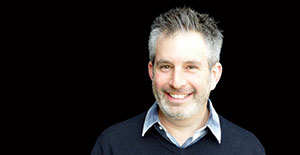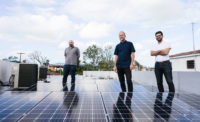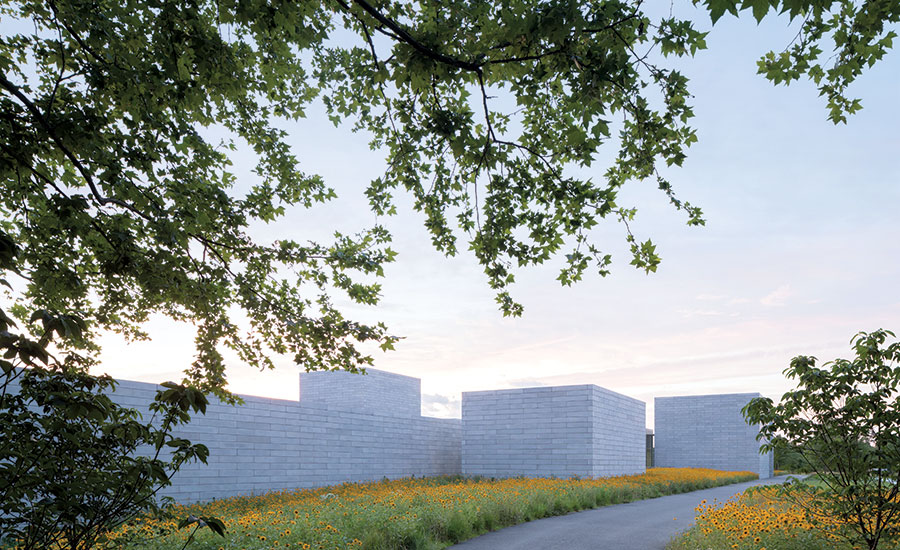Interview with Adam Greenspan
The landscape architect discusses the vastly different scales of his work.

The Pavilions at Glenstone
Photo © Iwan Baan, courtesy Glenstone Museum

The Pavilions at Glenstone from the air with Richard Serra’s Contour 290 (2004) at bottom and Tony Smith’s Smug (1978/2005) in the middle.
Photo © Iwan Baan, courtesy Glenstone Museum

Salesforce Park, which stretches out above the new transit center, 70 feet up, next to San Francisco’s tallest skyscraper offers a verdant respite for urbanites.
Photo © Steel Blue

Salesforce Park, which stretches out above the new transit center, 70 feet up, next to San Francisco’s tallest skyscraper offers a verdant respite for urbanites.
Photo © Tim Griffith

The approach to the Gallery at Glenstone is part of the choreography through the landscape to get visitors to slow down and slip into a quieter contemplative world.
Photo © Iwan Baan

Image courtesy PWP Landscape Architecture

Image courtesy PWP Landscape Architecture







Architects & Firms
Keep your eye on Adam Greenspan, design partner at the Berkeley-based PWP Landscape Architecture, founded by the esteemed Peter Walker. Greenspan is just completing two remarkable—and vastly different—projects in which landscape and architecture are inextricably intertwined. For Glenstone, in suburban Maryland, a 200-acre park with a new contemporary art museum designed by Thomas Phifer and Partners, set to open in October, Greenspan and his team created a 21st-century arcadia for the clients, Mitchell and Emily Rales; in San Francisco, the office has built a five-acre respite for urbanites atop the Salesforce Transit Center designed by Pelli Clark Pelli (PCP), amidst a cluster of skyscrapers, including the city’s tallest, Salesforce Tower, also by PCP. Greenspan spoke with RECORD editor in chief Cathleen McGuigan about the two projects. Here are excerpts from their conversation.
It’s hard to imagine two more different landscape designs than Glenstone in rural Maryland and the transit center park in the heart of San Francisco.
Yes, there is a drastic difference but, that said, as in all our projects, we really try to bring together nature and the cadence of life, whether it’s about the seasons or the lives of trees, or about stone and geological time. And even though these projects are in very different settings, with very different programs, we’re working closely with architects to bring an aspect of art and nature into the lives of people who move through these places.
At Glenstone, your role began long before Tom Phifer designed the new museum, when the late Charles Gwathmey was working on the Gallery there.
When we first came to the site in 2003, the property was probably about 40 or 50 acres. We were incredibly impressed with the scale and the way that it sat. Even though it had been graded for a subdivision, with engineered ditches, we thought there was a bigger potential. So, rather than having water go into ditches and drains, we let it flow over meadows. We worked with the client to purchase adjacent properties, so it is now 200 acres. It is not being restored so much as becoming a new place that highlights the beauty of the systems of the natural world. It was taking what was the suburb to become someplace more pastoral. On the other hand, the Salesforce site was all infrastructure, where freeways and overpasses and the old bus depot once were. Those were demolished, and now, in San Francisco, it’s a new kind of urbanism, with multiuse structures that are part of an integrated new neighborhood.
People might think a landscape architect makes things green and plants trees, but, really, you create experiences. Tom Phifer has talked about a choreographed experience for the visitor at Glenstone.
Yes, we thought about how you take visitors and slow them down from the way they’re moving through life. From the entrance, we curved the driveway and made the drive go through an allée of trees, at the edge of the woods. So it is really about slipping from one world to another. You leave the car and walk into the trees and begin walking across the meadow. It’s all about a procession—the opening up of spaces, as in a building, but at a much larger scale that’s about landscape and about time.
We think of architecture as timeless—you know, as the cliché goes, as frozen music. But the way you think about designing and managing the landscape has everything to do with time.
What’s been amazing at Glenstone is being part of the cultivation and evolution of the site over time. We’ve been able to see things change, like a grove of pines that we put in in 2003 that looked like a solid mass of green, but then the trunks grow up, and the grove becomes more transparent. We all are confident that if you come back to Glenstone a number of times, you’ll see different aspects of the landscape, at different times of the year but also if you come back when you’re young and when you’re old.

Photo courtesy PWP Landscape Architecture
But the experience is not just about movement and change, but also about framing views from inside the museum.
Yes, there is one room, with a big window looking back out at the landscape, at a knoll with honey locust trees on it, which are very light and airy. So, at the culmination of moving through the bigger landscape, when you get to the building, we were able to conceive, with Tom, another choreography within the Pavilions, where visitors would walk and experience the interior watercourt and its plants—lilies, irises, rushes—and frogs or dragonflies or butterflies. That’s the center of the space. And this is another place where people can see seasonal changes, or even weekly changes, each time they go. So you can have a very insulated experience of the art in one of the rooms and then come back out and focus on the watercourt again.
At Salesforce Park, how did you plan the visitor experience?
We also choreographed the experience there, but one difference is there’s not a single point of entry—we wanted to make it accessible from as many locations as possible. When we began in 2007, we thought, how do we get people up to the roof for a public park in the middle of the city—will they definitely go 70 feet in the air? All the streets that go under the building or border the two ends of the building have elevators that bring you up to the roof, so you can start your experience at any point along what is a continuous half-mile circuit path. And you can come from inside the Grand Hall in the Transit Center, up an elevator or an escalator, underneath the part of the park that has a skylight over the interior space.
You managed to create, in a relatively small space, so many different zones and experiences in this urban park.
Its shape—one block wide by four blocks long—allows a sequence of experiences.
In working with Pelli Clark Pelli, your park required hiding and burying architectural mechanicals, plus incorporating the skylights. Yet you wanted to make this artificial topography look parklike.
We worked closely with the architect—and also Pete Walker, my senior partner, came up with the topographical idea of hiding the architectural pop-up. Together he and I worked on the original competition design. We made an unusual topography of glass and grass and ground cover, so that, overall, it doesn’t feel like you’re on a roof in the city or you’re on the paved streetscape of the downtown, but feels instead like you’re in some place, I hope, that is new and unusual but connected to nature.
On both projects, you worked with artists— obviously, at Glenstone, where there are a number of outdoor sculptures, and at Salesforce, where you worked with Ned Kahn.
That’s been ongoing. Even at the beginning at Glenstone, we worked back and forth with Richard Serra’s studio, and we were on-site with Ellsworth Kelly, with a mock-up of his piece that we moved around together to site in the landscape. At Salesforce, together with Ned, we developed a way that his fountain would be completely integrated into the park. His idea was that the jets in the fountain would be triggered by buses that arrived below. It’s not an objectlike art piece, but runs almost the full length of the park.
The park itself is extremely varied.
We were able to create all these different, almost residential-scale gardens. We have the Chilean garden, the New Zealand and the Australian gardens. We also have a prehistoric garden, which has plants of the same types that grew at the time of dinosaurs—and they actually found a mammoth tooth when they were excavating the site. All these gardens and plants were chosen because they are suited to the climate of the Bay area— even though they’re from far-off places.
But choosing to use specimens from distant locations, you’re creating something a bit surreal. Glenstone seems more “natural,” with almost all-native species and even local stone.
Exactly. At Salesforce, you notice the singular specimens or combinations you see next to each other with all of that being on a roof. At Glenstone, it’s about the total envelopment inside of an amazing landscape that changes with the seasons. The stone we have used, carderock, comes from a quarry 15 minutes away. All of these moments, where you see things that are organic get organized into some kind of order, will be where Glenstone reveals that it’s been thought out, designed, and intentional. But, also, people who walk through the meadow might think, “That’s the way the meadow always has been”—when in fact we’ve regraded about 75 acres in order to get it to look that way.
Obviously, the challenges in creating both Glenstone and Salesforce were immense.
They were both hard. You could naturally think that Salesforce was more difficult, because it’s so technical to make a park on a roof. We have an average of 3 feet of soil over the whole building. And creating drainage, as well as just the structure and construction coordination, has been very, very difficult. But Glenstone wasn’t easy either, when you think of the scale: 200 acres. And we planted over 8,000 trees, and also moved over 400 existing trees on the site. Glenstone also has a constructed wetland in the middle of the museum, and others in the woods.
If you’re an architect, you finish a building and hand it over to the client, but as a landscape architect you have to be extraordinarily patient, because your work really flowers 10 or 20 years later.
With landscape architecture, there are things we do that are more static—the paving, a stone wall—but, as you’re looking at everything, you’re growing it with your eyes through time. At Glenstone, when you look at it at a distance, it’s not that everything grows and lives. Some things also die. Some branches get cut off, some ground cover or the meadow evolves. It’ll begin as very mixed, with flowers and grass, but over time, it will become more grassy, with fewer flowers. There are key places where a line of trees, or a grid of trees or the trees on the knoll, are meant to be maintained as they are laid out, but there are other large expanses which are meant to evolve and change, and that’s part of the concept of the design. Our design intent isn’t about staying static—it’s about things changing.












